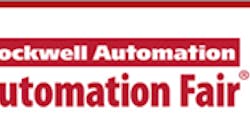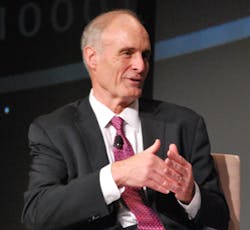In 2014, The Connected Enterprise was a vision.
“This year, our focus is on the implementation,” said Rockwell Automation Chairman and CEO Keith Nosbusch, who opened Automation Perspectives in Chicago with the company’s blueprint for connecting and integrating intelligent devices in an architecture that is future-proofed.
“The Connected Enterprise is the digital enterprise. It includes a high-performance architecture for integrated control and information.”
Rockwell Automation, with $6.3 billion in fiscal 2015 sales, is the largest company in the world that is solely focused on industrial power, control and information solutions, explained Nosbusch. The global automation giant, with its 22,000 employees in more than 80 countries, turned 112 years old this year.
Three core platforms—Integrated Architecture, Intelligent Motor Control and solutions and services—are architected and designed to deliver The Connected Enterprise through solutions that enable faster time to market, lower total cost of ownership, improved asset utilization, reduced downtime and increased throughput and quality.
With so many legacy systems in place, some with useful lives that won’t expire for another 10-15 years, manufacturers need investment strategies to determine how to get where they need to be.
“It starts with at least having a picture of where you want to end up,” explained Nosbusch. “You don’t know what you’re going to learn along the way.”
One given of IT and OT convergence is Ethernet. Start with a contemporary, standard, unmodified Ethernet infrastructure, which doesn’t limit your choice of products or solutions because it’s an open architecture.
“Future-proofing high-performance architecture delivers business value across the entire automation investment lifecycle.” Rockwell Automation Chairman and CEO Keith Nosbusch opens Automation Perspectives at Rockwell Automation Fair in Chicago.
“You might only be doing information and control now, but you’ll want to do voice and video and mobility in the future,” Nosbusch said. “You can evolve at your own pace. It’s incrementally deployable—you modify as you go.”
IT and OT
The need to converge IT and OT—the business network and the plant floor—is central to achieving The Connected Enterprise.
“IT is transactional data, such as orders, supply network or product design,” explained Nosbusch. “OT is real-time data, things like control, safety and security. Our partnership with Cisco is the foundation for an IT/OT convergence, which enables open communication between smart assets and the realization of The Connected Enterprise.”
Forward-thinking manufacturers are combining IT and OT organizations, said Nosbusch. “We see organizations that are combining those two or having them collaborate as integrated control and information,” he explained. “Some companies will fight it, but other companies see the end game. The reason they used to fight is because they didn’t trust each other.”
An industrial asset only becomes smart when it has a microprocessor and it’s connected to a network. It needs to be what Nosbusch calls “self-aware” and “system-aware.” As examples, the ability to realize self-diagnostics and calculate energy use is self-awareness. System-awareness means it can be integrated for safety and security.
“Our new Kinetix 5700 servo drive, for example, is self-tuning, which reduces scrap and improves energy efficiency,” offered Nosbusch. “This is self-aware. A system-aware example comes from our work with Fanuc, which helps to ensure the safety of an automated work cell. Self-aware and system-aware assets, when combined with the network, make The Connected Enterprise a reality.”
Real applications
The three key tenets of The Connected Enterprise are that it’s smart, productive and secure. “Even apps on a smart phone are important foundations of our high-performance architecture,” said Nosbusch.
The PlantPAx DCS from Rockwell Automation is based on open communication standards, breaking the mold of the conventional, closed DCS. “It’s scalable, and it’s information-enabled with IT-OT integration.”
Rockwell Automation customer Full Sail Brewing in Hood River, Oregon, wanted to increase its productivity without compromising quality. “We deployed PlantPAx with FactoryTalk Historian, VantagePoint and Logix Batch & Sequence Manager,” explained Nosbusch. “We reduced brew cycle times by half, cut raw material costs by 5% and increased brewing capacity by 25%.”
The manufacturing sector generates and stores 2 exabytes of data annually, more than any other sector. “There’s a general belief that all analytics will happen at the cloud,” said Nosbusch. “We believe there’s great value that can occur at the source. The closer to the source, the faster we can close the loop and act on them. Real-time analytics result in real-time action. This requires three steps—contextualization, analytics and actions.”
The oil and gas industry has assets in the field that personnel can only read and monitor by driving to them. One company is working with Rockwell Automation for remote performance monitoring, with real-time analytics running on the controller.
“We are using VantagePoint for visualization,” said Nosbusch. “We’re working with Microsoft and AT&T so operators can now look at health and performance on a smart phone. They can understand the down-hole condition of the well. Our solution allows monitoring and well management based on need, and not on a schedule.”
Secure IT-OT convergence and operational intelligence can be a challenge when there’s lots of legacy software and the need for enterprise visibility. PepsiCo identified many challenges, such as inefficient network communications. Rockwell Automation provided industrial data centers, industry-standard Ethernet and round-the-clock support. By replacing old computers, reliability improved and troubleshooting time was reduced by 90%.
Ford Motor is another company that saw a financial benefit. It had five different scheduling systems around the world, and, in some cases, the platforms were no longer supported by the vendors. Ford connected systems across the globe with FactoryTalk ProductionCentre, resulting in smoother vehicle production, managed in real time.
With more than 2 million variations in Ford models, the system, now in place in 25 of Ford’s 40 vehicle assembly plants, enables global production based on local supply and demand conditions.
Finally, BeingMate, a Chinese baby and child food company, wanted to double production capacity and needed electronic batch records to comply with the China Food & Drug Administration requirements.
“We deployed a system that is fully integrated with the plant’s ERP, which resulted in a 3% increase in productivity,” explained Nosbusch. “The system also delivered a 7% reduction in labor costs by reducing manual data entry.”
Future-proofed and partner-fortified
Because Rockwell Automation customers use a large number of third-party tools, future-proofing high-performance architecture so it isn’t obsolete before the payback period ends is a credible way to deliver business value across the entire automation investment lifecycle—from design to operation through maintenance.
As looming as the threat of obsolescence is, cybersecurity also stands as a potential hurdle to adoption.While cybersecurity is no longer an excuse not to implement, it’s still a concern for organizations.
“It’s just like safety,” explained Nosbusch. “We had a reliable PLC, and then we added the safety function to it. Over time, it became the norm. Security will ultimately become the norm of a control system because who would put something in that isn’t secure, just like who would put in a PLC without safety. It’s available.”
To deliver The Connected Enterprise, Rockwell Automation has partnered with both IT and OT companies. Those partners include AT&T, Microsoft and Cisco on the IT side, as well as Endress+Hauser, Panduit and Fanuc on the OT side.
“No one company can offer everything that’s needed,” explained Nosbusch. “Our strategic partners and over 100 Encompass partners are essential.”






